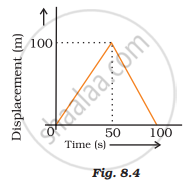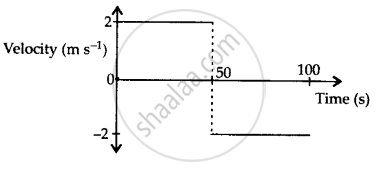Advertisements
Advertisements
Question
A girl walks along a straight path to drop a letter in the letterbox and comes back to her initial position. Her displacement–time graph is shown in Fig.8.4. Plot a velocity-time graph for the same.

Solution
From displacement – time graph,
velocity = `"displacement"/"time"`
= `(100"m")/(50"s")`
= 2ms−1
The symmetry of the graph shows that the girl comes back to her initial position with the same velocity (2 ms−1) but in opposite direction. So, the velocity-time graph will look like

APPEARS IN
RELATED QUESTIONS
Give one example of a situation in which a body has a certain average speed but its average velocity is zero.
A cheetah starts from, rest, and accelerates at 2 m/s2 for 10 seconds. Calculate :
(a) the final velocity
(b) the distance travelled.
Derive the formula : v = u + at, where the symbols have usual meanings.
When a car driver travelling at a speed of 10 m/s applies brakes and brings the car to rest in 20 s, then retardation will be :
A bus increases its speed from 36 km/h to 72 km/h in 10 seconds. Its acceleration is :
Give one example of following motion :
Variable acceleration
State how the velocity-time graph can be used to find
The acceleration of a body
For a uniformly retarded motion, the velocity-time graph is _____________
When is the positive acceleration?
An electron moving with a velocity of 5 × 104 ms−1 enters into a uniform electric field and acquires a uniform acceleration of 104 ms–2 in the direction of its initial motion.
(i) Calculate the time in which the electron would acquire a velocity double of its initial velocity.
(ii) How much distance the electron would cover at this time?
